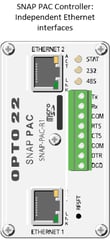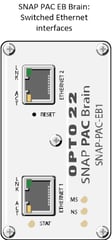Opto 22 SNAP PAC controllers and brains both have two Ethernet network interfaces—pretty handy. But do you use them the same way? That's the question we'll answer in this tech tip.
Most devices used on an Ethernet network have one network interface with an RJ-45 connector. But SNAP PAC controllers and EB brains each have two interfaces—two RJ-45 connectors.
However, the two interfaces on controllers and brains are designed for different uses.
 SNAP PAC Controllers
SNAP PAC Controllers
On a SNAP PAC S-series or R-series controller, the two interfaces are independent, with separate IP addresses. If you use both, they must be on separate networks or network subnets.
If you have a Wired+Wireless PAC, you have three independent network interfaces: two for Ethernet and the third for wireless. Again, each interface is independent, has its own IP address, and must be on a separate network or subnet.
The main advantage of the separate, independent interfaces is that you have additional networking options, such as redundant network links.
When you set up the controller, plug a Category 5 or newer cable into the connector marked Ethernet 1. You must use Ethernet 1, not Ethernet 2, because the controller sends a BootP request for an IP address from Ethernet 1 only. After you assign the IP address to Ethernet 1, you can use PAC Manager to assign an IP address to the other interface(s).
 SNAP PAC Brains
SNAP PAC Brains
The two interfaces on SNAP PAC EB brains, however, are designed differently: they are not independent. Instead, they're switched interfaces that share the same IP address and work just like an Ethernet switch.
Standard networking for Ethernet devices is in a star configuration, with an Ethernet switch or router as the center of the star. But with the EB's switched interfaces, you can daisy-chain brains, similar to serial networks.
For a standard star configuration, you use just one interface. For daisy-chaining, you use both to link I/O units without the need for a separate switch. If you daisy-chain, make sure connections are in a simple open-ended chain, not a loop or ring.
Daisy-chaining offers advantages and disadvantages. The main advantage is the reduced expense, because you don’t need to purchase Ethernet switches. The main disadvantage is that if you lose communication with a brain, all the brains after that one in the chain are also unreachable.
When you set up an EB brain for standard networking, you can plug a Cat 5 or newer cable into either connector. It doesn’t matter which one you use.
Note that if you have a Wired+Wireless EB brain, the wireless interface is independent from the two wired ones. Configure the IP address using a wired interface first, and then use PAC Manager to assign the wireless IP address.
For more information
Check out the SNAP PAC System Specification Guide for more on networking options (Chapter 3), plus product specs, comparisons, wiring diagrams, and system architecture illustrations for all the parts in the SNAP PAC System.
Software, controllers, brains, I/O modules, and accessories like power supplies—they're all in this handy guide.

